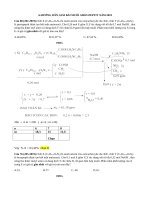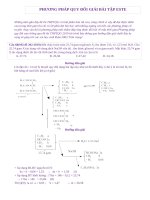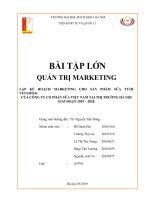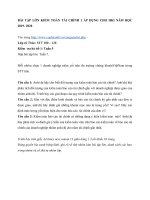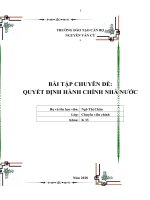bài tập dckttd clc 2020 group accounts
Bạn đang xem bản rút gọn của tài liệu. Xem và tải ngay bản đầy đủ của tài liệu tại đây (940.99 KB, 14 trang )
<span class="text_page_counter">Trang 1</span><div class="page_container" data-page="1">
<b>GROUP ACCOUNTS </b>
<b><small>EXERCISE 1: </small></b>
<small>The parent acquired 60% of company X’s $100m ordinary share capital on 1/1/N for a cash payment of $150m and a further payment of $50m on 31/12/N of the subsidiary’s post acquisition profits have exceeded an agreed figure by that date. </small>
<small>In the financial statements for the year to 31/12/N $50m will be added to the cost of the combination discounted as appreciate. </small>
<small>Required: Cost of combination? </small>
<b><small>EXERCISE 2: </small></b>
<small>P co bought a 25% shareholding on 31/12/N in A co at a cost of $38.000. During the year 31/12/N+1, A co made a profit after tax of $50.000. A dividend of $20.000 was paid on 31.12 out of this profit </small>
<small>Required: How A co will be accounted for in the individual and consolidated account of P co for the year end 31/12/N+1 </small>
<b><small>EXERCISE 3: </small></b>
<small>On 31 December 20X1 P Co acquired 80% of S Co for $10,000,000. At this date the fair of S Co's net assets are $7,500,000. Calculate goodwill. </small>
<b><small>EXERCISE 4: </small></b>
<small>Sing Co acquired the ordinary shares of Wing Co on 31 March 20X1 when the draft </small>
<b><small>statements of financial position of each company were as follow: </small></b>
<small>SING CO </small>
<small>STATEMENT OF FINANCIAL POSITION AT 31 MARCH 20X1 </small>
<b><small> $’000 Assets </small></b>
</div><span class="text_page_counter">Trang 3</span><div class="page_container" data-page="3"><small>Prepare the consolidated statement of financial position at 31 March 20X1. </small>
<b><small>EXERCISE 5: </small></b>
<small>On 1 January 20X1, P acquired 80% of the share capital of subsidiary S. The net assets of S were valued at $200,000 at the date of acquisition and P paid $200,000 to acquire the shares in S. The summary statements of financial position of both entities at 1 January 20X1 are as follow: </small>
<small>Summary statement of financial position 1 January 20X1 </small>
<small>Summary statement of financial position </small>
</div><span class="text_page_counter">Trang 4</span><div class="page_container" data-page="4"><small>770,000 240,000 Equity: </small>
<small> Fair value (S co) </small>
<small>Differences </small>
<small>Assets </small>
<small>- Cash 600.000.000 50,000,000 50,000,000 - Receivables from </small>
<small>customers </small>
<small>1.000.000.000 50,000,000 50,000,000 </small>
<small>- Inventories 400.000.000 60,000,000 75,000,000 15,000,000 - Intangible fixed assets </small>
<small>(Land use right) </small>
<small>900.000.000 40,000,000 100,000,000 60,000,000 </small>
<small>- Tangible fixed assets </small>
<small> (Building and equipment) </small>
<small>2.000.000.000 600,000,000 590,000,000 (10,000,000) </small>
<small>- Accumulated (600.000.000) (300,000,000) (300,000,000) </small>
</div><span class="text_page_counter">Trang 5</span><div class="page_container" data-page="5"><small>Liabilities 1.800.000.000 200,000,000 235,000,000 (35,000,000) </small>
<small>- Payables to suppliers 1.000.000.000 100,000,000 100,000,000 </small>
<small>- Non-current liabilities (Issued bonds) </small>
<small>800.000.000 100,000,000 135,000,000 (35,000,000) </small>
<small>Equity 2.500.000.000 300,000,000 </small>
<small>- Equity shares </small>
<small> (par value 10,000 d/shares) </small>
<small>1/Make journal entries in P company at 1 January 20X1 </small>
<small>2/ Prepare the consolidated statement of financial position as at 1 January 20X1 </small>
<b><small>EXERCISE 8: </small></b>
Cloud obtained a 60% holding in the 100,000 $1 shares of Mist on 1 January 20X8, when the retained earnings of Mist were $850,000. Consideration comprised $250,000 cash, $400,000 payable on 1 January 20X9 and one share in Cloud for each two shares acquired. Cloud has a cost of capital of 8% and the market value of its shares on 1 January 20X8 was $2.30.
Cloud measures non controlling interest at fair value- . The fair value of the controlling interest at 1 January 20X8 was estimated to be $400,000.
non-What was the goodwill arising on acquisition? $139,370
$169,000 $119,370 $130,370
</div><span class="text_page_counter">Trang 6</span><div class="page_container" data-page="6">On 1 August 20X7 Patronic purchased 18 million of the 24 million $1 equity shares of Sardonic. The acquisition was through a share exchange of two shares in Patronic for every three shares in Sardonic. The market price of a share in Patronic at 1 August 20X7 was $5.75. Patronic will also pay in cash on 31 July 20X9 (two years after acquisition) $2.42 per acquired share of Sardonic. Patronic's cost of capital is 10% per annum.
What is the amount of the consideration attributable to Patronic for the acquisition of Sardonic?
$105 million $139.5 million $108.2 million $103.8 million <small>!</small>
<b><small>EXERCISE 10: </small></b>
Crash acquired 70% of Bang's 100,000 $1 ordinary shares for $800,000 when the retained earnings of Bang were $570,000 and the balance in its revaluation surplus was $150,000. Bang also has an internally-developed customer list which has been independently valued at $90,000. The non-controlling interest in Bang was judged to have a fair value of $220,000 at the date of acquisition. What was the goodwill arising on acquisition?
A $200,000B $163,000C $226,000D $110,000
<b><small>EXERCISE 11: </small></b>
Highveldt, a public listed company, acquired 75% of Samson's ordinary shares on 1 April 20X4. Highveldt paid an immediate $3.50 per share in cash and agreed to pay a further amount of $108 million on 1 April 20X5. Highveldt's cost of capital is 8% per annum. Highveldt has only recorded the cash consideration of $3.50 per shahe summarised statements of financial position of the two companies at 31 March 20X5 are shown below:
</div><span class="text_page_counter">Trang 7</span><div class="page_container" data-page="7"><small>Highveldt Samson </small>
<small>Property, plant and equipment (note (i)) 420 320 </small>
<small>Equity and liabilities </small>
<small>Reserves: </small>
<small>Retained earnings – 1 April 20X4 160 134 </small>
<small>The following information is relevant: </small>
Ø Highveldt has a policy of revaluing land and buildings to fair value. At the date of acquisition Samson's land and buildings had a fair value $20 million higher than their carrying amount and at 31 March 20X5 this had increased by a further $4 million (ignore any additional depreciation).
Ø Samson had established a line of products under the brand name of Titanware. Acting on behalf of Highveldt, a firm of specialists, had valued the brand name at a value of $40 million with an estimated life of ten years as at 1 April 20X4. The brand is not included in Samson's statement of financial position.
Ø It is the group policy to measure non-controlling interest fair value. The fair value of the non controlling interest in Samson at the acquisition date was -$83 million.
Required: Calculate Goodwill as it would appear in the consolidated statement of financial position of Highveldt at Acquisition date.
<b><small>EXERCISE 12: </small></b>
On 1 October 20X8 Pacemaker acquired 30 million of Vardine's 100 million
</div><span class="text_page_counter">Trang 8</span><div class="page_container" data-page="8">shares in exchange for 75 million of its own shares. The stock market value of Pacemaker's shares at the date of this share exchange was $1.60 each.
Vardine's profit is subject to seasonal variation. Its profit for the year ended 31 March 20X9 was $100 million.
$20 million of this profit was made from 1 April 20X8 to 30 September 20X8. Pacemaker has one subsidiary and no other investments apart from Vardine. What amount will be shown as 'investment in associate' in the consolidated statement of financial position of Pacemaker as at 31 March 20X9?
A $144 millionB $150 millionC $78 millionD $126 million
<b><small>EXERCISE 13: </small></b>
Ulysses owns 25% of Grant, which it purchased on 1 May 20X8 for $5 million. At that date Grant had retained earnings of $7.4 million. At the year end date of 31 October 20X8 Grant had retained earnings of
$8.5 million after paying out a dividend of $1 million. On 30 September 20X8 Ulysses sold $600,000 of goods to Grant, on which it made 30% profit. Grant had resold none of these goods by 31 October.
At what amount will Ulysses record its investment in Grant in its consolidated statement of financial position at 31 October 20X8?
<b><small>EXERCISE 14: </small></b>
Ruby owns 30% of Emerald and exercises significant influence over it. Emerald sold goods to Ruby for $160,000. Emerald applies a one third mark up on cost. Ruby still had 25% of these goods in inventory at the year end.
What amount should be deducted from consolidated retained earnings in respect of this transaction?
<b><small>EXERCISE 15: </small></b>
The following information relates to questions 1- 4.
On 1 October 20X6 Plateau acquired the following non-current investments:
</div><span class="text_page_counter">Trang 9</span><div class="page_container" data-page="9">3 million equity shares in Savannah by an exchange of one share in Plateau for every two shares in Savannah plus $1.25 per acquired Savannah share in cash. The market price of each Plateau share at the date of acquisition was $6 and the market price of each Savannah share at the date of acquisition was $3.25. 30% of the equity shares of Axle at a cost of $7.50 per share in cash.
Only the cash consideration of the above investments has been recorded by Plateau.
Extracts from the summarised draft statements of financial position of the three companies at 30 September 20X7 are:
Plateau Savannah Axle $'000 $'000 $'000 Equity shares of $1 each 10,000 4,000 4,000 Retained earnings
– at 30 September 20X6 16,000 6,000 11,000 – for year ended 30 September 20X7 9,250 2,900 5,000 The following information is relevant. 35,250 12,900 20,000 Ø It is the group policy to value non-controlling interest at acquisition at fair value. For this purpose the share price of Savannah at the acquisition date should be used.
1/What is the total of the consideration paid by Plateau for Savannah? A $3,750,000
B $9,750,000C $12,750,000D $21,750,000
2/ What amount will be shown as non-controlling interest in the consolidated statement of financial position at 30 September 20X7?
A $3,900,000B $3,250,000C $3,225,000D $3,975,000
3/ What amount will be shown in the consolidated statement of financial position at 30 September 20X7 in respect of the investment in Axle?
</div><span class="text_page_counter">Trang 10</span><div class="page_container" data-page="10">A $9,000,000B $10,500,000C $14,000,000D $30,000,000
4/ Plateau is negotiating a contract to supply goods to Axle in the coming year (ended 30 September 20X8) at 20% profit. How will the unrealised profit on the sale of these goods be adjusted in the consolidated financial statements for the year ended 30 September 20X8?
A DR Share of profit of associates CR Group inventory B DR Share of profit of associates CR Investment in associate C DR Group inventory CR Share of profit of associate D DR Investment in associate CR Share of profit of associate
<b>EXERCISE 16: Merge with goodwill </b>
P Plc. has the following transactions: (Unit: $1,000)
1. P Plc. acquired S Plc. at 31/12/N and had settled as follows: - By cash at bank: 2,450 at 31/12/N
- By a tangible fixed asset with fair value of 180 (VAT 10% was excluded). The asset had the initial cost of 300 and accumulated depreciation of 140.
- By issuing 1,000 bonds with par value of 1/bond, the maturity term of 3 years and interest rate of 10% per annum. The market price of those bonds was 1.05 per bond.
Simultaneously, P Plc. had hired consultants, asset valuation experts and auditors with an amount of 100 and the cost of bond issuance of 6, all of which were paid by cash at bank.
After the acquisition, only P Plc. existed and S Plc. dissolved.
2. The pre-acquisition Statement of Financial Position for the year ended 31/12/N of the two companies were as follows:
Item P Plc. S Plc. ASSETS
</div><span class="text_page_counter">Trang 11</span><div class="page_container" data-page="11">- Cash- Inventories
- Tangible fixed assets + Cost
+ Accumulated depreciation - Intangible fixed assets
15,000 200 50,000 100,000 (50,000) 500
3,000 100 15,000 18,000 (3,000) 100
LIABILITIES Trade payables Borrowings
Equity Share capital Share premium Undistributed profit
30,000 10,000 20,000
35,700 20,000 10,700 5,000
15,000 5,000 10,000
3,200 1,600 600 1,000
3, At the date of acquisition, the book value of assets and liabilities items of S Plc. were equal to their fair value with the following exceptions:
- Inventories that had fair value of 90;
- Tangible fixed assets that had fair value of 15,500
<b>Requirements: </b>
1. Calculate the cost of combination and goodwill?
2. Prepare relevant journal entries for the transaction at 31/12/N?
<b>EXERCISE 17: Business combination forming parent company and subsidiary with goodwill. The parent company owns less than 100% of the subsidiary. </b>
</div><span class="text_page_counter">Trang 12</span><div class="page_container" data-page="12">P Plc. has the following transactions: (Unit: $1,000)
1. At 31/12/N, P Plc. acquired 70% ordinary shares of S Plc. and had made the payment by the following forms:
- By issuing 2 million 0.01 shares which had market price of 0.014.
- The cost of shares issuance was 1,000 and the fees for consultants (included in cost of combination) was 2,000. All were paid by cash at bank.
2. The pre-acquisition Statement of Financial Position for the year ended 31/12/N of the two companies were as follows:
(Book value)
S (Fair value) Cash 40,000 30,000 30,000 Trade receivables 70,000 20,000 18,000 Inventories 90,000 60,000 55,000 Fixed assets 130,000 50,000 45,000 Total 330,000 160,000 148,000 Trade payables 40,000 30,000 30,000 Long-term borrowings 30,000 10,000 12,000 Other payables 30,000 20,000 20,000 Share capital 170,000 70,000
Share premium 30,000 10,000 Undistributed profit after tax 30,000 20,000
</div><span class="text_page_counter">Trang 13</span><div class="page_container" data-page="13">Total 330,000 160,000
<b>Requirements: </b>
1. Calculate the cost of combination and goodwill?
2. Make relevant journal entries for the transaction at 31/12/N in P Plc. ledgers? 3. Make journal entries for preparing consolidated financial statements acquisition date?
<b>EXERCISE 18: Investment in associates with goodwill, upstream (sales by associate to investor) transactions </b>
1. At 1/1/N, P Plc. owned some subsidiaries and acquired 300,000 out of 1,200,000 issued shares of A Plc. with the payment by the following forms: - Share exchange: 125,000 ordinary shares with par value of 10 and fair value of 15 per share.
- Bond exchange: 1,000 bonds with total par value of 1,000 and total fair value of 1,000,000.
- The fees for consultants and revaluation experts 500,000 were paid by cash at bank.
P Plc. had a significant influence on the financial and operating policy of A Plc. 2. At the acquisition date, the SOFP of A Plc. was as follow:
Assets 24,400,000 Liabilities and Equity 24,400,000 Cash 2,000,000 Short-term borrowings 13,000,000 Receivables 3,000,000 Share capital 11,000,000 Inventories 3,400,000 Undistributed PAT 400,000 Fixed assets 16,000,000
3. At acquisition date, the book value of A’s assets and liabilities was equal to their fair value with the following exceptions:
- Inventories that had fair value of 3,600,000; - Fixed assets that had fair value of 16,600,000. 4. In year N:
- At 30/3/N: A Plc. had distributed all the dividends from the retained earnings
</div><span class="text_page_counter">Trang 14</span><div class="page_container" data-page="14">at 31/12/N-1.
- A Plc. had sold all inventories that were in stocks at 1/1/N.
- At 30/11/N, A Plc. sold to P a consignment with cost of 1,000,000 and selling price of 1,300,000. Until 31/12/N, P had not sold this consignment yet. - A’s net profit for the year N was 5,000,000. The company had temporarily distributed 2,000,000 as the dividends at 30/9/N by cash at bank.
5. In year N+1, P Plc. had sold all of the goods that was purchased from A Plc. and the profit for year N+1 of A was 4,500,000
</div>
